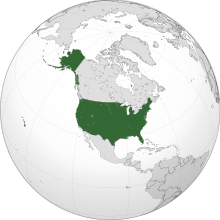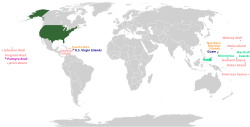User:NiklawskiMSTM/Iodni zad
Error: no context parameter provided. Use {{other uses}} for "other uses" hatnotes. (help). Template:Good article is only for Wikipedia:Good articles.
United States of America | |
|---|---|
| Motto:
Other traditional mottos
| |
| Anthem: "The Star-Spangled Banner" | |
 | |
 The United States and its territories | |
| Capital | Washington, D.C. 38°53′N 77°01′W / 38.883°N 77.017°W |
| Largest city | New York City 40°43′N 74°00′W / 40.717°N 74.000°W |
| Official languages | None at federal level |
| Recognised regional languages | |
| National language | English[b] |
| Demonym(s) | American |
| Government | Federal presidential constitutional republic |
| Barack Obama | |
| Joseph Biden | |
| John Boehner | |
| John Roberts | |
| Legislature | Congress |
| Senate | |
| House of Representatives | |
| July 4, 1776 | |
| March 1, 1781 | |
| September 3, 1783 | |
| June 21, 1788 | |
| August 21, 1959 | |
| Area | |
• Total | 9,857,306[5] km2 (3,805,927 sq mi) (4th) |
• Water (%) | 2.23 |
| Population | |
• 2015 estimate | 320,206,000[6] (3rd) |
• Density | 34.2/km2 (88.6/sq mi) (180th) |
| GDP (PPP) | 2013 estimate |
• Total | $16.72 trillion [7] (1st) |
• Per capita | $52,800 [7] (10th) |
| GDP (nominal) | 2013 estimate |
• Total | $16.768 trillion[8] (1st) |
• Per capita | $53,042[9] (9th) |
| Gini (2013) | 38.0[10][11][12] medium |
| HDI (2013) | very high (5th) |
| Currency | [[]] ($) (USD) |
| Time zone | UTC−5 to −10 |
• Summer (DST) | UTC−4 to −10[d] |
| Driving side | right[e] |
| Calling code | +1 |
| ISO 3166 code | US |
| Internet TLD | .us .gov .mil .edu |
| |
The United States of America (U.S.A.), commonly referred to as the United States (U.S.) or America, is a federal republic[20][21] consisting of 50 states and a federal district. The 48 contiguous states and Washington, D.C., are in central North America between Canada and Mexico. The state of Alaska is located in the northwestern part of North America and the state of Hawaii is an archipelago in the mid-Pacific. The country also has five populated and nine unpopulated territories in the Pacific and the Caribbean. At 3.80 million square miles (9.85 million km2)[5] and with over 320 million people, the United States is the world's fourth-largest country by total area and third-largest by population. It is one of the world's most ethnically diverse and multicultural nations, the product of large-scale immigration from many countries.[22] The geography and climate of the United States are also extremely diverse, and the country is home to a wide variety of wildlife.[23]
Paleo-Indians migrated from Eurasia to what is now the U.S. mainland around 15,000 years ago,[24] with European colonization beginning in the 16th century. The United States emerged from 13 British colonies located along the East Coast. Disputes between Great Britain and the colonies led to the American Revolution. On July 4, 1776, as the colonies were fighting Great Britain in the American Revolutionary War, delegates from the 13 colonies unanimously issued the Declaration of Independence. The war ended in 1783 with the recognition of independence of the United States from the Kingdom of Great Britain, and was the first successful war of independence against a European colonial empire.[25] The country's constitution was adopted on September 17, 1787 and ratified by the states in 1788. The first ten amendments, collectively named the Bill of Rights, were ratified in 1791 and designed to guarantee many fundamental civil rights and freedoms.
Driven by the doctrine of manifest destiny, the United States embarked on a vigorous expansion across North America throughout the 19th century.[26] This involved displacing American Indian tribes, acquiring new territories, and gradually admitting new states, until by 1848 the nation spanned the continent.[26] During the second half of the 19th century, the American Civil War ended legal slavery in the country.[27] By the end of that century, the United States extended into the Pacific Ocean,[28] and the economy, driven in large part by the Industrial Revolution, began to soar.[29] The Spanish–American War and World War I confirmed the country's status as a global military power. The United States emerged from World War II as a global superpower, the first country to develop nuclear weapons, the only country to use them in warfare, and as a permanent member of the United Nations Security Council. The end of the Cold War and the dissolution of the Soviet Union left the United States as the sole superpower.[30]
- ^ 36 U.S.C. § 302 National motto
- ^ Simonson, 2010
- ^ Dept. of Treasury, 2011
- ^ "U.S. Code: Title 36, 304". United States Code. United States: Cornell Law School. August 12, 1998. Retrieved February 15, 2015.
The composition by John Philip Sousa entitled 'The Stars and Stripes Forever' is the national march.
- ^ a b c "State and other areas", U.S. Census Bureau, MAF/TIGER database as of August 2010, excluding the U.S. Minor Outlying Islands. viewed October 22, 2014.
- ^ "U.S. and World Population Clock". U.S. Census Bureau. Retrieved January 17, 2015.
- ^ a b Cite error: The named reference
WFwas invoked but never defined (see the help page). - ^ "GDP (current US$)". World Bank Open Data. The World Bank. Retrieved January 20, 2015.
- ^ "GDP per capita (current US$)". World Bank Open Data. The World Bank. Retrieved January 20, 2015.
- ^ "OECD Income Distribution Database: Gini, poverty, income, Methods and Concepts". Organisation for Economic Co-operation and Development.
- ^ "Global inequality: How the U.S. compares". Pew Research.
- ^ "Income Distribution and Poverty : by country - INEQUALITY". OECD.
- ^ "2014 Human Development Report Summary" (PDF). United Nations Development Programme. 2014. pp. 21–25. Retrieved July 27, 2014.
- ^ Cite error: The named reference
ILWwas invoked but never defined (see the help page). - ^ New Mexico Code 1-16-7 (1981).
- ^ New Mexico Code 14-11-13 (2011).
- ^ Cobarrubias, Juan; Fishman, Joshua A. (1983). Progress in Language Planning: International Perspectives. Walter de Gruyter. p. 195. ISBN 90-279-3358-8. Retrieved December 27, 2011.
- ^ García, Ofelia (2011). Bilingual Education in the 21st Century: A Global Perspective. John Wiley & Sons. p. 167. ISBN 1-4443-5978-9. Retrieved December 27, 2011.
- ^ "Ecological Footprint Atlas 2010" (PDF). Global Footprint Network. Retrieved July 11, 2011.
- ^ The New York Times Guide to Essential Knowledge, Second Edition: A Desk Reference for the Curious Mind. St. Martin's Press. 2007. p. 670. ISBN 978-0-312-37659-8.
- ^ Onuf, Peter S. (1983). The Origins of the Federal Republic: Jurisdictional Controversies in the United States, 1775–1787. Philadelphia: University of Pennsylvania Press. ISBN 978-0-8122-1167-2.
- ^ Adams, J.Q.; Strother-Adams, Pearlie (2001). Dealing with Diversity. Chicago: Kendall/Hunt. ISBN 0-7872-8145-X.
- ^ "Wildlife Library". National Wildlife Federation. Retrieved December 23, 2014.
- ^ Cite error: The named reference
earliestwas invoked but never defined (see the help page). - ^ Greene, Jack P.; Pole, J.R., eds. (2008). A Companion to the American Revolution. pp. 352–361.
Bender, Thomas (2006). A Nation Among Nations: America's Place in World History. New York: Hill & Wang. p. 61. ISBN 978-0-8090-7235-4.
"Overview of the Early National Period". Digitial History. University of Houston. 2014. Retrieved February 25, 2015. - ^ a b Carlisle, Rodney P.; Golson, J. Geoffrey (2007). Manifest Destiny and the Expansion of America. Turning Points in History Series. ABC-CLIO. p. 238. ISBN 978-1-85109-833-0.
- ^ "The Civil War and emancipation 1861–1865". Africans in America. Boston, MA: WGBH. Retrieved March 26, 2013.
Britannica Educational Publishing (2009). Wallenfeldt, Jeffrey H. (ed.). The American Civil War and Reconstruction: People, Politics, and Power. America at War. Rosen Publishing Group. p. 264. ISBN 978-1-61530-045-7. - ^ White, Donald W. (1996). "1: The Frontiers". The American Century. Yale University Press. ISBN 0-300-05721-0. Retrieved March 26, 2013.
- ^ "Work in the Late 19th Century". Library of Congress. Retrieved January 16, 2015.
- ^ Tony Judt; Denis Lacorne (June 4, 2005). With Us Or Against Us: Studies in Global Anti-Americanism. Palgrave Macmillan. p. 61. ISBN 978-1-4039-8085-4.
Richard J. Samuels (December 21, 2005). Encyclopedia of United States National Security. SAGE Publications. p. 666. ISBN 978-1-4522-6535-3.
Paul R. Pillar (January 1, 2001). Terrorism and U.S. Foreign Policy. Brookings Institution Press. p. 57. ISBN 0-8157-0004-0.
Gabe T. Wang (January 1, 2006). China and the Taiwan Issue: Impending War at Taiwan Strait. University Press of America. p. 179. ISBN 978-0-7618-3434-2.
Understanding the "Victory Disease," From the Little Bighorn to Mogadishu and Beyond. DIANE Publishing. p. 1. ISBN 978-1-4289-1052-2.
Akis Kalaitzidis; Gregory W. Streich (2011). U.S. Foreign Policy: A Documentary and Reference Guide. ABC-CLIO. p. 313. ISBN 978-0-313-38375-5.


